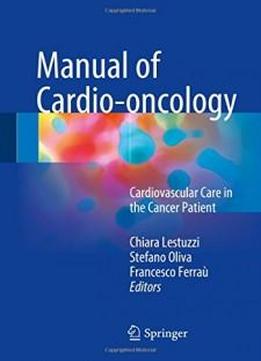
Manual Of Cardio-oncology: Cardiovascular Care In The Cancer Patient
by Chiara Lestuzzi /
2017 / English / PDF
24.6 MB Download
This concise and handy manual provides straightforward, up-to-date
guidance for cardiologists and other practitioners on the
management of cancer patients with cardiac problems, whether they
be due to the cancer itself or to antineoplastic treatment.
Detailed attention is devoted to the various forms of
cardiotoxicity associated with chemotherapy and radiotherapy. The
drugs commonly responsible for each toxicity are identified and
clear advice is offered on monitoring techniques and treatment
approaches. In addition, the issue of cardiotoxicity due to cancer
treatment in particular patient groups – children, the elderly, and
those with pre-existing cardiac disease – is addressed separately,
with guidance on when and how antineoplastic (and/or cardiological)
treatments should be modified. Further sections describe the
correct responses to cardiac problems secondary to the cancer
itself, including thromboembolic disorders and electrolyte
imbalances, and the diagnosis, treatment, and follow-up of cardiac
tumors. A closing section considers how to improve
cooperation between oncologists, cardiologists, and general
practitioners to ensure that cancer patients’ cardiovascular needs
are met in a multidisciplinary approach.
This concise and handy manual provides straightforward, up-to-date
guidance for cardiologists and other practitioners on the
management of cancer patients with cardiac problems, whether they
be due to the cancer itself or to antineoplastic treatment.
Detailed attention is devoted to the various forms of
cardiotoxicity associated with chemotherapy and radiotherapy. The
drugs commonly responsible for each toxicity are identified and
clear advice is offered on monitoring techniques and treatment
approaches. In addition, the issue of cardiotoxicity due to cancer
treatment in particular patient groups – children, the elderly, and
those with pre-existing cardiac disease – is addressed separately,
with guidance on when and how antineoplastic (and/or cardiological)
treatments should be modified. Further sections describe the
correct responses to cardiac problems secondary to the cancer
itself, including thromboembolic disorders and electrolyte
imbalances, and the diagnosis, treatment, and follow-up of cardiac
tumors. A closing section considers how to improve
cooperation between oncologists, cardiologists, and general
practitioners to ensure that cancer patients’ cardiovascular needs
are met in a multidisciplinary approach.











